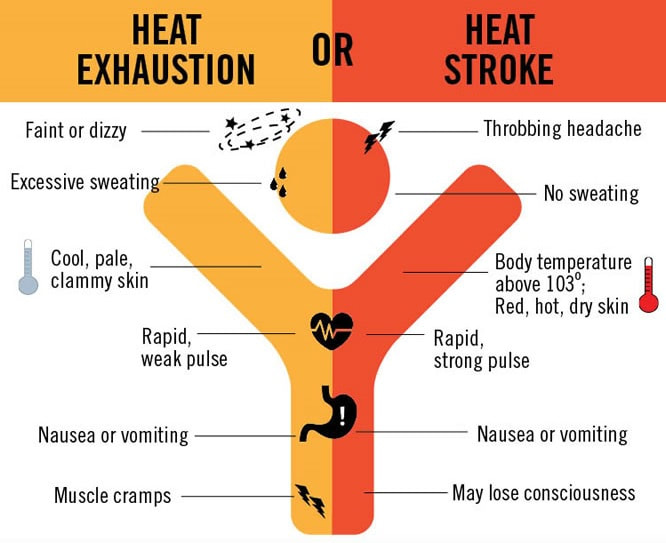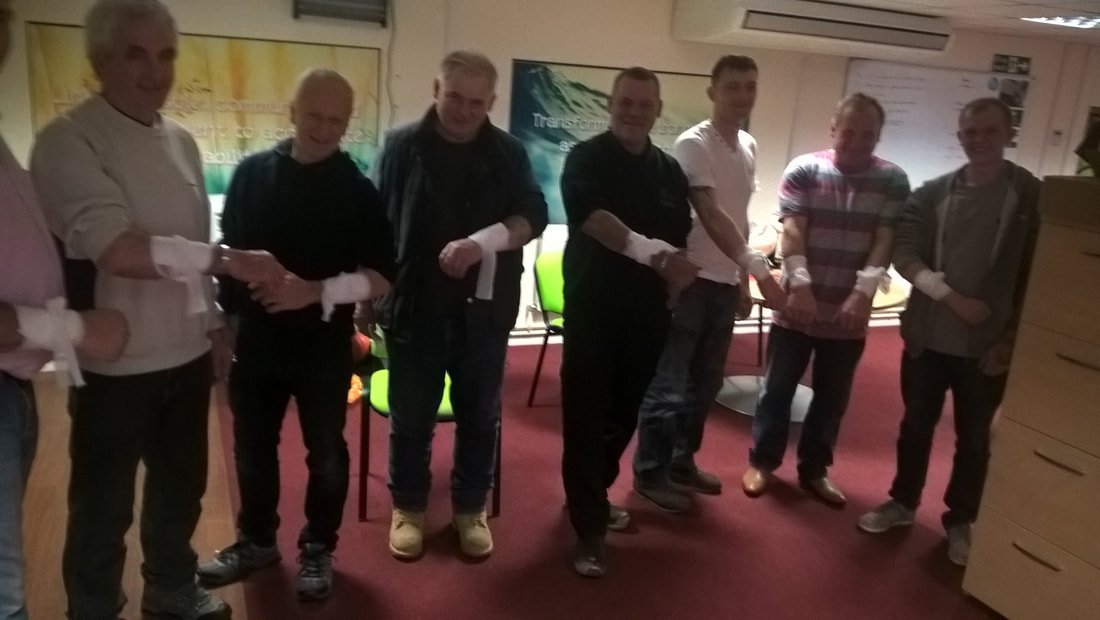|
Heat Exhaustion and Heat Stroke, what’s the difference?
Heat Exhaustion is the body’s response to dehydration, most commonly caused by working or exercising in hot conditions. It can usually be treated by a First Aider, but if left untreated it can rapidly develop into life threatening Heat Stroke(in which case call for an ambulance immediately). Heat Stroke is when the temperature control in the brain fails, the body is unable to cool down and the causalities core temperature can reach very dangerous levels within 10 to 15 minutes. This can be caused by prolonged exposure to high temperatures or fevers. Recognising Heat Exhaustion
0 Comments
Causes Ultraviolet rays from the sun, sun lamps and on rare occasions certain types of radiation. Signs and Symptoms Reddening of the skin, pain in the associated area and in cases of severe sunburn blistering of the skin. Treatment
Severe sunburn with blistering and peeling skin.
I suggest you that you steer clear of those online “how many first aiders do you need” calculators found on many Training Company websites. Simply because the Health and Safety Executive guidance is that you should look at your organisation and ask some sensible questions:
• How many employees/customers do you have? • How many locations do you operate in? • How long would it take to get the emergency services there? • What shifts do employees work? • How dangerous is their work environment? Once you know the areas that you need to look at and how likely there is to be a First Aid incident, you then have to decide if you have enough cover. This is called a “First Aid Needs Assessment” and it is your responsibility, you will have to justify your decisions if something goes wrong and you didn’t provide sufficient first aid. Rather helpfully the Health and Safety Executive does provide some case studies to guide you. For example, if you have an office with eighty employees spread evenly over two floors working normal business hours with good access to emergency services, you would always need at least one first aider on duty on each floor, fully trained on the one-day first aid course (Emergency First Aid at Work). To cover for absence and holidays you would have to train at least four employees or possibly more. Another case study given is a construction maintenance crew of twenty working in teams of two, sometimes working at height, with electricity etc., travelling in transit vans up to ten miles from the nearest hospital. In this case you would need at least one first aider per team trained, up to the three-day first aid course (First Aid at Work). Once again, to cover for staff holidays and absence you would probably have to have at least twelve team members trained. The area of the Health and Safety Executive website dealing with First Aid is worth a visit as it has a lot more case studies in greater detail as well as lots of clear guidance written in plain English. A very good short Canadian film about the impact of Asbestos. Loughborough University is global leader in research for driver ergonomics they have produced a short guide to adjusting your car seat position to reduce and avoid back pain. It is a system I have followed myself and can attest that while the new seating position feels very weird at first it has significantly reduced the pain I experience after long journeys. I have posted their guide free to download on my website here. I would urge you to give this approach a try and to share this post when anyone you know who suffers from back pain aggravated by driving.
Manual Handling is responsible for one third of all workplace injuries, sadly there is a lot of low quality, out of date manual handling training going on, which does little to reduce the number of injuries (or claims). Do you know which manual handling activity causes your team the most concern? Have team members been trained to report dangerous activities to you? Have you done anything to try and make these tasks safer? The HSE have produced a whole series of free booklets to help you manage this one. To access these free resources click hereToday I delivered a free Health and Safety Workshop at the Yorkshire School Business Leadership Conference and it was really fun. Judging from the feedback the delegates enjoyed the workshop and took away some useful tips they could quickly implement in their organisations. If you attended the workshop and want to download any of the free resources or links we talked about they are here.
It was the first conference that I have done for a few years and I had such a great time I am keen to do another. So if you are planning a conference and want a short practical session on health and safety with lots of useful take aways send and email to info@castlehill-training.com I know some people find Health and Safety a “dry” topic but I pride myself that I can bring some humour and keep everyone engaged. Ladder training why do we wait until someone dies?
Last week I was speaking to friend who is a national expert in working at height training, with a great reputation in the safe use of ladders and he mentioned how busy he was at the moment. When I asked why, he explained there had been a successful prosecution of a company in Hull for the death of a worker who had fallen from a ladder and that whenever this happens the phone doesn’t stop ringing. Why do we wait until it goes wrong before we get our team trained? http://press.hse.gov.uk/2017/bakery-fined-after-the-death-of-contractor/ Saturday First Aid Courses are the only many busy organisations can catch up with their first aid training. I had a great day today with this lot, they had me in stiches I could hardly keep a straight face.
If your organisation can report and act on your near misses you can radically reduce the number of accidents that occur, the benefits here are huge and the costs are minimal. This is a big win for improving safety and reducing costly accidents.
So, there are different definitions out there, but in this article, we will say and an accident is an unplanned, unwelcome event that resulted in harm and a near miss is an unplanned, unwelcome event that did not result in harm but could have done, a close shave in essence. Depending on how you measure these things you will typically have around ten near misses for every one accident. Near misses are therefore a much bigger data set for identifying the real hazards in your operation. Even better when you investigate near-misses people tend to be much more candid and forthcoming, as they are less likely to get into trouble. Acting on near misses lets you see where the accidents are going to come from and do something to make things safe before there is an accident. If you are not seeing multiple near misses reported for every accident then your team isn’t reporting them. How do you get your team to start reporting near misses? Some companies set targets for near-miss reporting, or provide incentives or make a charity donation for every near miss reported. There are downsides to these approaches, personally, I think educating your team is the key. Regardless of which approach or approaches you take one thing you can do to improve your near miss reporting is make the process itself easy. Big forms don’t get filled in. That brilliant three-page document you have painstakingly drafted (capturing every relevant fact about the event and tracking how your health and safety team have acted on it) won’t get filled in. Make it easy, quick and simple to record near misses, I have a sample A5 near miss report card free for you to download from my website here. The card doubles up as a safety suggestion card and the idea is that you print a load of these, give them to everyone in your organisation, your contractors and your visitors let them fill them in and pop them in your suggestion box. If you are thinking of using this card as a template why not add your telephone number or email to encourage people to phone in or email there near misses. |
AuthorSteve Celli is the Senior Tutor at Castle Hill Training, don't be fooled by his youthful good looks he has decades of experience in training. Archives
February 2023
Categories |
Proudly powered by Weebly







 RSS Feed
RSS Feed